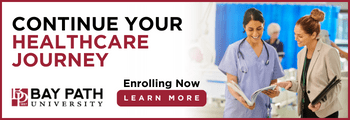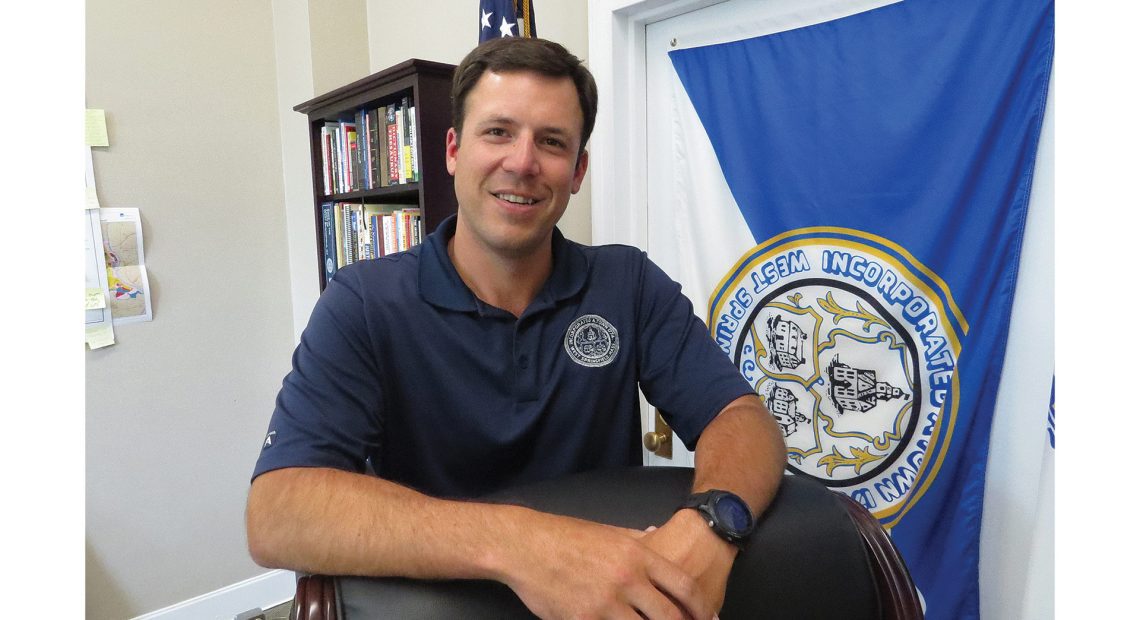Community Spotlight
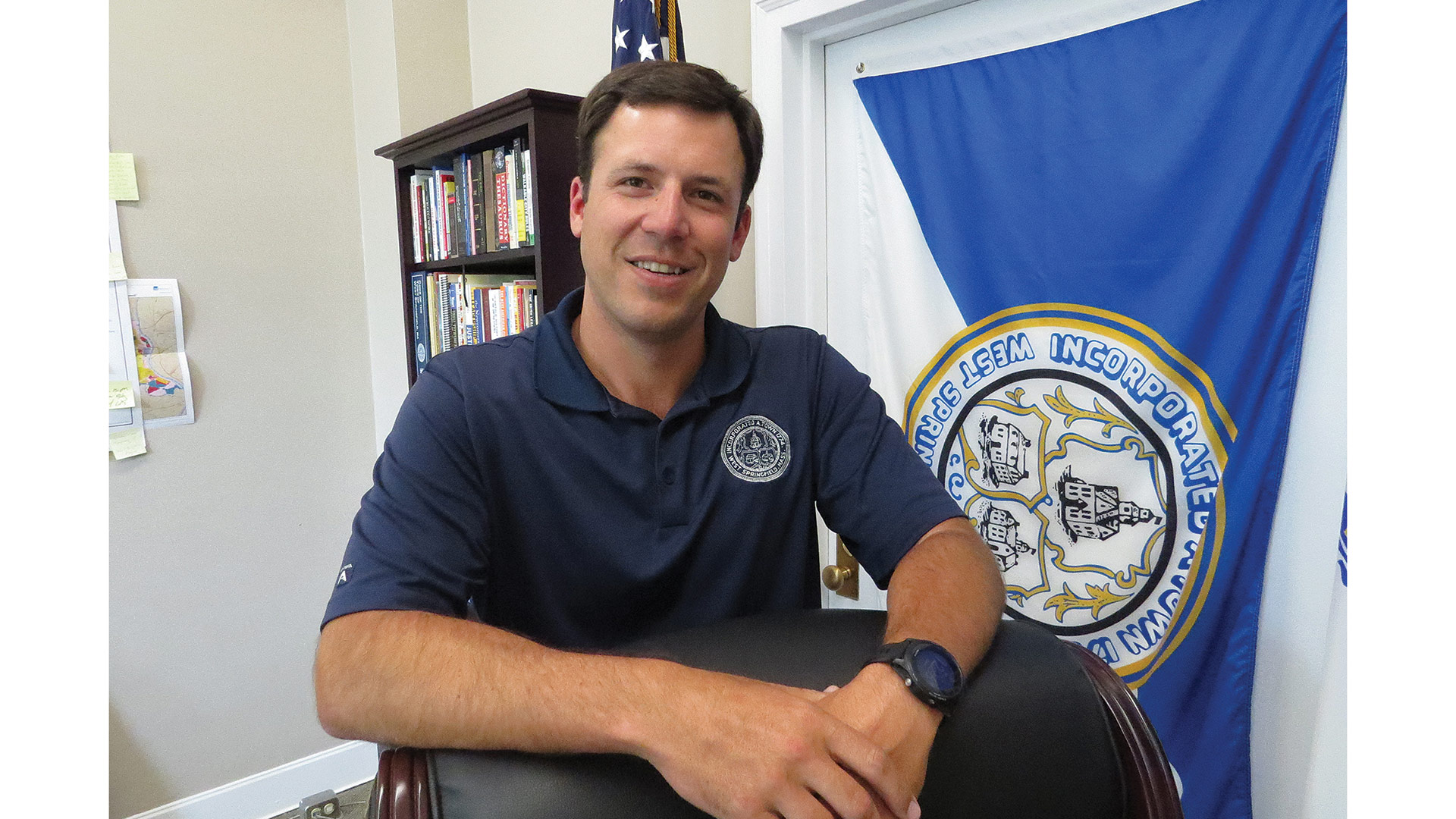
Mayor William Reichelt says West Springfield is making significant progress on many of the goals he set when first elected in 2015.
While the country will be celebrating its 250th birthday in 2026, West Springfield will mark that same milestone two years earlier.
And the planning for what will be a huge party is very much underway, said Mayor William Reichelt, noting that a committee has been put together, chairs of that board have been selected, and a dialogue will soon be launched with town residents to determine how, where, and in what ways they want to observe that birthday.
And while two years will go by quickly, especially with all this planning and execution to handle, this community that operates as a city but still calls itself a town could look much different by the time the big party kicks off.
Several of its major roadways, including Memorial Avenue and sections of Route 5, will be redone or in the process of being redone (hopefully the former, said the mayor as he crossed his fingers — figuratively, anyway) by then. There will be some new businesses on those stretches — Amherst Brewing is moving into the former Hofbrauhaus property, for example — and some of them well before 2024. And there may actually be some cannabis-related ventures in this town that has thus far said ‘no’ to this now-booming industry; a critical City Council vote on the matter took place on July 18, just after this issue of BusinessWest went to press, and Reichelt, who backed a measure to permit the licensing of such establishments, was confident that he had the requisite six votes for passage.
“Once I got into this, there was so much I wanted to do, and I quickly realized that nothing happens fast.”
“We’re in a much different place than we were four years ago, when it was 8-1 [against],” he said, adding that the measure would enable businesses to be located on large stretches of Riverdale Street, the preferred location among those in that industry.
And there is a chance, albeit a slight chance at this point, that the massive power-generating plant near the rotary at the Memorial Bridge may disappear from the landscape it has dominated for decades. Indeed, it has been decommissioned, and its owners are deciding what to do with the property.
“We’re in discussions now about what remediation will look like; I would like to see a clean site so another developer can do something with it, but we’re still in the talking stage,” Reichelt said, adding that the community is looking closely at what happened with a similar but larger property in Salem that is being redeveloped.
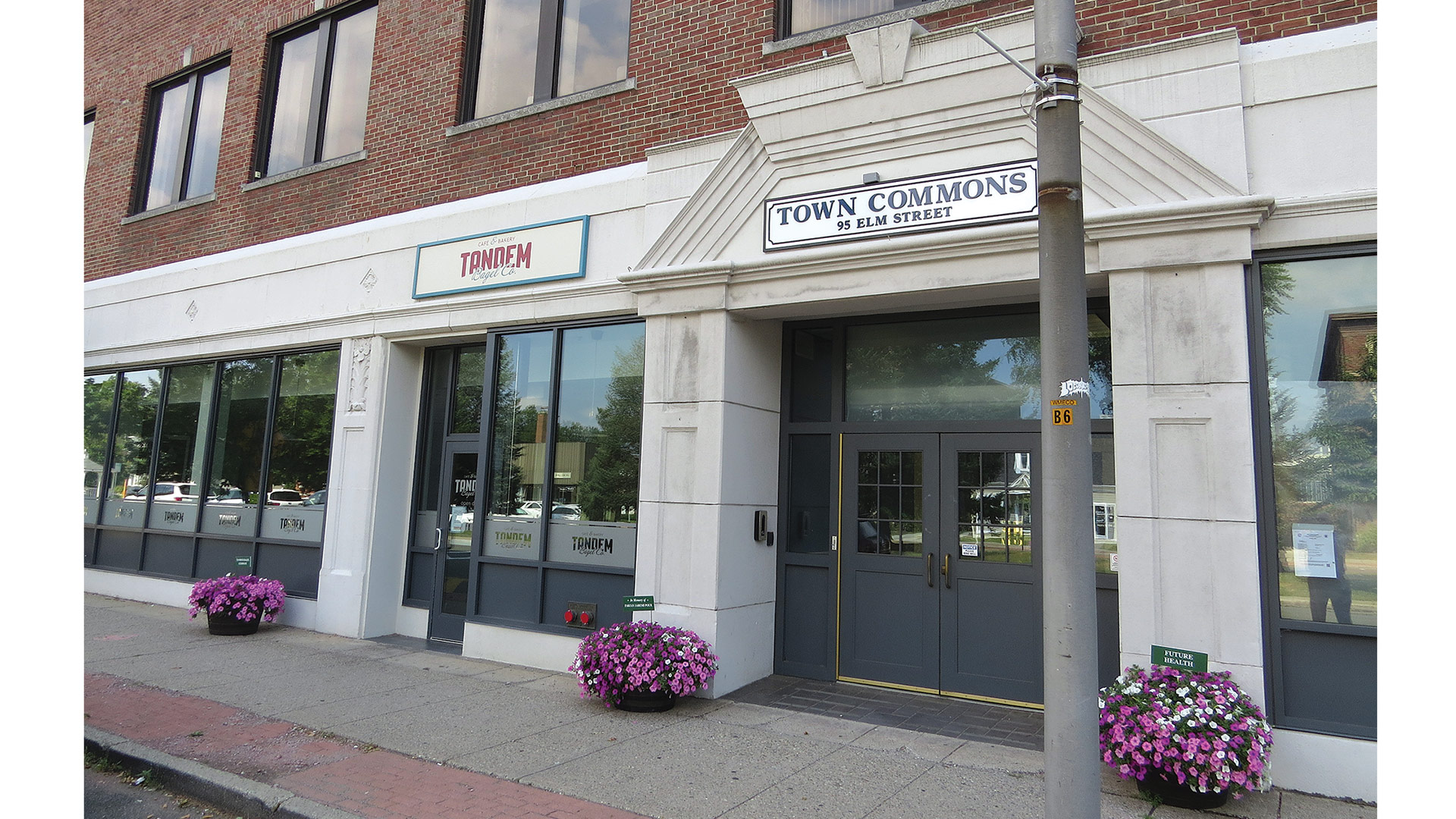
The renovated 95 Elm St., now known as Town Commons, features an eclectic mix of businesses and will soon add a restaurant.
But enough about what might and might not happen over the next two years. For now, West Springfield and its mayor are making progress on many of the goals he set down when he was first elected in 2015, including infrastructure, new schools and additions to existing schools, attracting new businesses, and creating what he called a “walkable downtown” with plenty of attractions.
Early on, he said he wanted to create ‘another Northampton.’ “But people have this weird dislike of Northampton, for some reason, so now, we say we want it to be like West Hartford,” Reichelt noted, adding that his community is certainly moving in that direction with initiatives ranging from a walking trail and improved infrastructure along the historic town green to the reinvention of 95 Elm St.
Formerly home to United Bank and still known to many as the ‘United Bank building,’ the three-story office complex is now home to a mix of businesses, and a new restaurant will soon be added to that mix.
For this, the latest installment of its Community Spotlight series, BusinessWest turns its focus on West Springfield and the many forms of progress being seen there.
Party Planning
Returning to the subject of the 250th birthday party, Reichelt said the wheels are in motion for that celebration, and some pieces are starting to fall into place.
That list includes a special commemorative 250th birthday beer to be created by Two Weeks Notice Brewing, which set up shop in West Springfield several years ago and has established a firm presence in the community; no word yet on just what this brew will be or what it will be called.
Meanwhile, old documents and photos are being collected, and a commemorative history — a significant update to one produced for the 200th birthday in 1974 — is being planned, said Reichelt, adding that there is preliminary talk of staging an event similar to the Taste of West Springfield that was put on for many years by the community’s Rotary Club.
“We’re talking about bringing something like that back, maybe with a food truck festival on the common,” he said, reiterating that planning for the 250th is still very much in the early stages.
And while this planning continues, officials are making progress on a number of different fronts in the community, everything from the planning of infrastructure work on Memorial Avenue and Riverdale Street to determining how to spend roughly $8 million in ARPA funds (other infrastructure projects are at the top of that list) to contemplating what might be done if that massive power plant actually comes down.
Reflecting on that list, and his first six and half years in office, Reichelt, now one of the longest-serving mayors in the region, said he’s learned during his tenure that it often (always?) takes a long time to get something done, and, as a result, communities and those who lead them must be patient and perseverant.
“Once I got into this, there was so much I wanted to do, and I quickly realized that nothing happens fast,” he told BusinessWest. “Projects that I started talking about back in 2016 … we’re just starting to get funding for and breaking ground now.”
As an example, he pointed to the last remaining piece, the restaurant at 95 Elm St., something he’s been pursuing for years and an element he believes will be a nice compliment to what already exists on that street — a few restaurants, the Majestic Theatre, and a bagel shop already at 95 Elm — and make the area more of a destination.

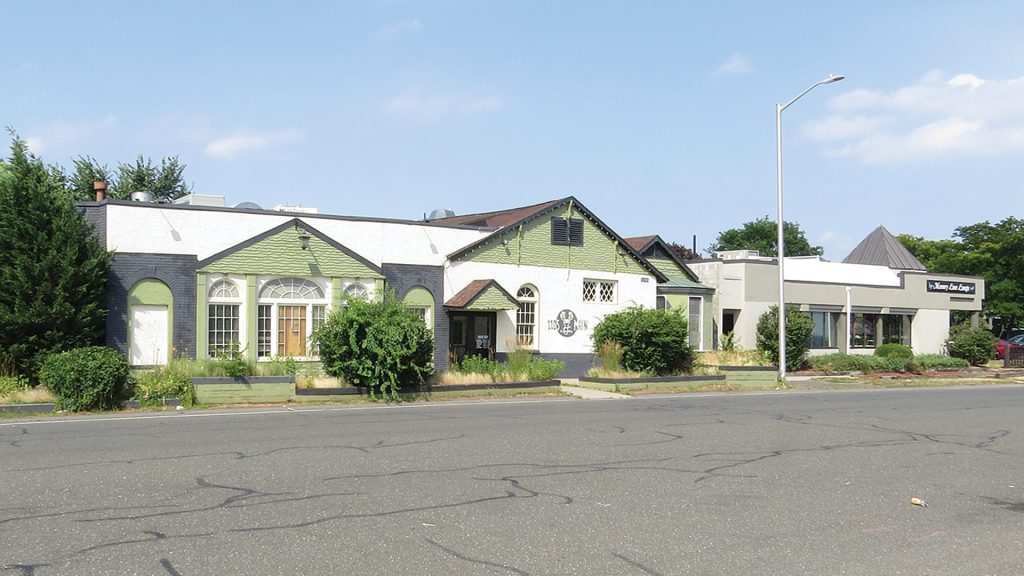
At top, the town common now boasts new walking paths. Above, the former Hofbrauhaus property will become a new site for Amherst Brewing.
It’s also taken some time to make the planned improvements to the green area, which now boasts new traffic lights, improved intersections, and a half-mile loop for walking and other uses, said the mayor, adding that a similar upgrade is planned for Elm Street.
“We want to bring people downtown and have it be a spot where you can walk around, go to the theater, have dinner in a couple of different places … make a night of it,” he said. “We have great commercial corridors on Memorial Avenue and Riverdale, but there’s no real place for people in town to go; to have a walkable downtown would be nice. It’s nice to see come that come to fruition after six years.”
Meanwhile, there are ambitious plans on the table for improving the full length of Memorial Avenue, from the Route 5 rotary to the recently widened Morgan Sullivan Bridge. The $25 million, state-funded project is slated to commence next April, and it will take two years to complete.
Significant work is also planned for Route 5 (Riverdale Street) and specifically the stretch north of I-91, said Reichelt, adding that the broad goal is to redevelop that section of the street, which has always been far less popular with retailers than the stretch south of the highway.
“There’s this perception … businesses have no desire to be north of the I-91 overpass,” he said. “They all want to be between the overpass and East Elm connection, where are no vacancies.”
As for the aforementioned power plant, it is very early in the process of deciding what its fate will be, said Reichelt, adding that, if all goes well, the community could have 10 acres of land right off Route 5 and Memorial Avenue that could be redeveloped for a number of uses. There is a landfill next door, so there are some limitations, he noted, but industrial, commercial, and infrastructure opportunities exist, including a connection to the rotary so that motorists can go both north and south from Agawam Avenue.
What’s Down the Road
But much of the attention is now focused on cannabis-related businesses, that July 18 vote, and what will likely happen if that measure passes.
At present, the only business allowed in West Springfield for cannabis-related ventures is to advertise their products and services on billboards along the highways that run through the community. That will change, of course, if the measure passes, as the mayor predicts it will, and he expects West Side to be an attractive mailing address for such companies.
“We want to bring people downtown and have it be a spot where you can walk around, go to the theater, have dinner in a couple of different places … make a night of it. We have great commercial corridors on Memorial Avenue and Riverdale, but there’s no real place for people in town to go; to have a walkable downtown would be nice. It’s nice to see come that come to fruition after six years.”
Indeed, Reichelt said he no longer uses the phrase ‘crossroads of the region’ to describe his community, preferring ‘retail capital of Western Mass.,’ a nod to the many regional and national retail heavyweights — from Costco to Dick’s Sporting Goods to Home Depot — that have located stores in the community.
The traffic that drew those major retailers should also attract cannabis businesses and especially dispensaries, he added.
Reichelt noted that he believes that there is sufficient momentum to get the measure passed, and there may be more with the recent 3% increase in property taxes, the town’s first in several years. Indeed, he said the tax revenue generated from cannabis-related businesses and its potential to help prevent another such increase in rates may help incentivize the council.
“It’s four years later, and the landscape has really changed,” he said. “You hear a lot of the same legalization arguments that you heard back in 2016, but that argument was settled in 2016 — it’s legal in Massachusetts now. To think that it’s not in town is … not based in reality. There are signs on Riverdale and Westfield Street and Memorial Avenue pointing to the different places you can buy marijuana outside of town; look at the tax money that’s leaving here.”
While the July 18 date was one to circle, there’s another key date fast approaching — Sept. 16. That’s the kickoff to the Big E, which will take another big step this year to returning to normal — as in 2019 conditions.
The fair was canceled in 2020, and while it was staged in 2021, it did not have a full lineup of entertainment, said Eugene Cassidy, president and CEO of the Big E, adding that, for 2022, it will be all systems go.
Much of the entertainment has already been announced, he said, noting that Lynyrd Skynrd will close the fair this year. Meanwhile, there will be a number of new attractions and events — including an opportunity for fair attendees to communicate with those at the International Space Station — and even food items, including noodles, vegan offerings, and full-sized donuts.
Cassidy said advanced ticket sales are running well ahead of the pace for last year, which was a near-record year for the fair, and other strong years. “People don’t even know what what the fair is going to offer, but they’re already supporting it by buying tickets, sometimes nine months in advance of the event,” he told BusinessWest. “And that provides a great deal of emotional support for those of us who run the place because we know that our patrons care about the organization.”
But while projections are certainly good for this year, he will watch closely what happens at several other state and regional fairs set to open in the coming weeks.
Indeed, one wildcard could be gas prices, which, while they’re coming down, remain historically high and could deter some families from driving long distances for entertainment.
Bottom Line
Reflecting on why this city still calls itself a town, Reichelt recalled that the vote to change the charter and convert from town government to city government was close — as in very close.
“They decided when they wrote the town charter to maintain the ‘town’ name to maintain that town feel,” he said, adding that many people have approached him and said ‘Will, it doesn’t feel like a town anymore.’
Such sentiments lead him to believe that maybe, just maybe, by the time West Springfield turns 250, it will not only operate a city government, but call itself a city.
If so, that will be only one of many potentially significant changes that will take place between now and then in a community where there is always movement and the landscape is, well, a work in progress.
George O’Brien can be reached at [email protected]


